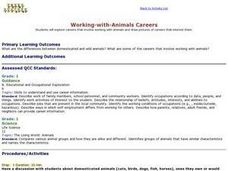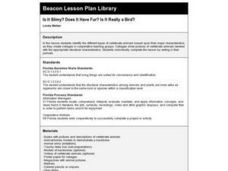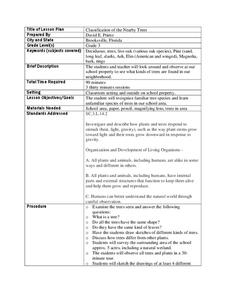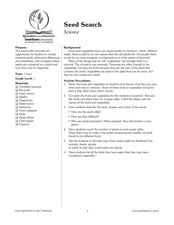Curated OER
Plant and Animal Cells: Alike and Different?
Seventh graders create a mneumonic device and a graphic organizer about the parts of plant and animal cells. In this biology lesson students are introduced to the parts of the cells and then work in groups to create projects that teach...
Curated OER
Look Alikes
Third graders compare and contrast the physical features of parents and offspring. In this life science lesson, 3rd graders classify a set of animal pictures according to their similarities. They share and explain their work in class.
Curated OER
Animals and Humans
Students identify the functions of various body parts. They participate in the "Head, Shoulders, Knees, and Toes" song, draw a picture of themselves and other mammals, and create a traced outline of their body that they add features to....
Curated OER
Animals in the Wild
Students compare/contrast paintings with similar subjects and themes. They discuss how a painting may relate to life experiences. Students draw animal families and compose a story about a painting by Gerome. They discuss zoos and...
Curated OER
Making Mittens with The Mitten Book
Students read The Mitten, by Jan Brett, and discuss the different animals in the book. They create a pair of paper mittens that look alike.
Curated OER
Animals and Animal Babies
Students examine how some animal young are similar to the adult. They look at pictures of various animals and their young and identify if they look similar or not similar to the adult animal, and draw a picture of a baby and parent...
Curated OER
Working-with-Animals Careers
First graders list and discuss careers that involve working with animals and draw pictures of careers that interest them. They compare and contrast domestic and wild animals.
Curated OER
Big Cat Classification
First graders discover the different names and classifications of big cats by using word processing applications. In this animal life lesson, 1st graders investigate one big cat and create a database of facts about it using an word...
Curated OER
The Discovery of OXygen
Students conduct experiments to identify the different properties of oxygen. In this chemistry lesson, students examine its importance to life on Earth. They explore the historic dispute about oxygen's discovery.
Curated OER
Classifying Vertebrates
Second graders study animal characteristics and classification. For this animal characteristics and classifications lesson, 2nd graders determine how to classify vertebrates which include mammals, reptiles, amphibians, birds, and fish....
Curated OER
Is It Slimy? Does It Have Fur? Is It Really a Bird?
Sixth graders identify the different types of vertebrate animals based upon their major characteristics, as they create collages in groups. Collages show pictures of vertebrate animals labeled with the appropriate structural...
Curated OER
Classification of the Nearby Trees
Third graders practice using classification techniques to identify local trees. In this plant life instructional activity, 3rd graders discuss how trees differ from other plants and what characteristics are unique to trees alone....
Curated OER
Activity Plan 3-4: Dreamy Rhymes
Learners write a story about an animal using rhyme. In this literacy lesson plan, the teacher shares different versions of "Mary Had a Little Lamb" with the class and that becomes the basis for the creation of a picture and story for...
Curated OER
Which Herp Is Which?
Students research different kinds of herps. The teacher gives the student a particular herp and the student writes a postcard (as the herp) to an in-class penpal, giving hints about the herp, but not identifying itself.
Curated OER
Making Mittens with The Mitten Book
Students read and discuss the different animals in The Mitten book and then try to make mittens that are alike.
Curated OER
Treetures
Students identify the different forests of the world and some of the characteristics that differentiate them. They explore old magazines, calendars and photos and fill out a scavenger hunt worksheet.
Curated OER
IDENTIFYING AND SORTING BEARS
Students study the difference between living and nonliving bears by classifying pictures of bears and placing them on the appropriate posterboard. Given pictures of bears, students recognize types of bears by placing the pictures correctly.
Curated OER
Where Are the Dinosaurs?
Students study dinosaurs by completing two activities and group discussion. In this dinosaur lesson plan, students discuss dinosaurs and extinction as a class. Students make dinosaur dioramas, a hatchable dinosaur egg after watching a...
Curated OER
Activity Plan 5-6: Book-Character Homes
Students use their creativity to build character homes. In this early childhood lesson plan, students develop creative-thinking, social, language, math, and motor skills as they work together to create buildings for characters from...
Curated OER
Seed Search
First graders examine seeds. In this fruits and vegetables lesson, 1st graders determine what fruits and vegetables have in common. Students cut open fruits and vegetables and examine their seeds. Students describe the sizes, shapes and...





















